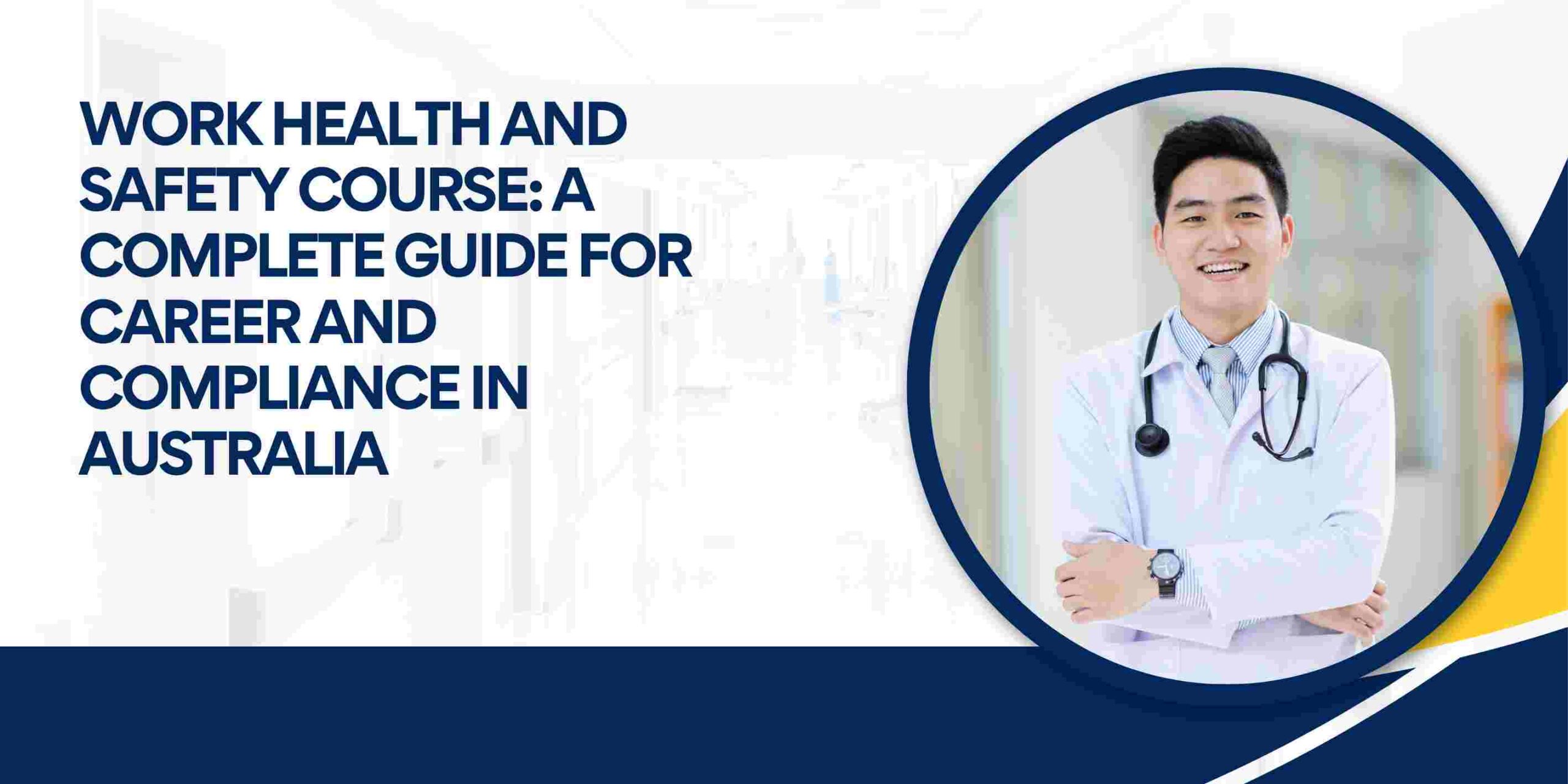Introduction
Work Health and Safety (WHS) is a critical aspect of every workplace in Australia. Employers and employees alike are legally and ethically obligated to ensure that their work environments are safe, secure, and free from risks that can cause injury or harm. A Work Health and Safety course provides the knowledge and skills required to identify hazards, assess risks, and implement effective safety measures across various industries. Whether you’re a manager, supervisor, frontline worker, or aspiring to enter safety-focused roles, completing a WHS course is a key step toward career growth, legal compliance, and safer workplaces.
In this extensive article, we’ll explore every essential detail related to Work Health and Safety courses in Australia, including course types, benefits, job roles, legal frameworks, delivery methods, qualifications, and career pathways.
What is Work Health and Safety?
Work Health and Safety, commonly abbreviated as WHS, refers to the systems, policies, and procedures implemented within a workplace to ensure the safety, health, and welfare of employees, contractors, and visitors. In Australia, WHS laws are governed by both state and federal legislation and aim to prevent workplace injuries and fatalities.
Core Principles of WHS
-
Risk Identification and Management: Spotting potential hazards before they cause harm.
-
Preventive Controls: Putting systems in place to reduce or eliminate risks.
-
Compliance with Legislation: Meeting national and state-specific WHS standards.
-
Continuous Improvement: Regularly reviewing and updating safety procedures.
Why Take a Work Health and Safety Course?
Taking a WHS course is more than just a compliance requirement—it’s an investment in safety, productivity, and professional development.
1. Legal Compliance
Australia has strict WHS laws. Employers and employees are both responsible for meeting specific obligations under the Work Health and Safety Act 2011. Completing a WHS course ensures you’re aware of your legal duties and how to meet them.
2. Career Advancement
A certified WHS qualification opens doors to many job roles, such as safety officers, site supervisors, and compliance managers. It adds credibility to your resume and signals your dedication to creating a safe work environment.
3. Risk Mitigation
Understanding WHS principles helps reduce accidents and injuries. This leads to lower insurance costs, less downtime, and better morale among workers.
4. Skill Development
Courses often include practical training in hazard identification, incident investigation, risk assessments, emergency planning, and safety audits. These are valuable skills in any industry.
Types of Work Health and Safety Courses
Australia offers a range of WHS courses suitable for various experience levels and roles. Below are the most common options:
1. Certificate III in Work Health and Safety
This entry-level course is ideal for those just starting in WHS roles or looking to add safety responsibilities to their current position.
-
Duration: 6–12 months (part-time/full-time)
-
Suitable for: General workers, junior safety officers
-
Topics covered: Hazard identification, incident response, reporting procedures
2. Certificate IV in Work Health and Safety
One of the most sought-after qualifications, this course is required for many supervisory and managerial WHS positions.
-
Duration: 6–12 months
-
Suitable for: Safety advisors, team leaders, WHS representatives
-
Topics covered: Risk assessment, legal obligations, safety management systems
3. Diploma of Work Health and Safety
Designed for professionals seeking to advance to senior roles or specialize in WHS.
-
Duration: 12–18 months
-
Suitable for: WHS managers, consultants
-
Topics covered: Complex risk management, legislation interpretation, auditing processes
4. Advanced Diploma of WHS
This course focuses on strategic implementation and development of WHS systems in large organizations.
-
Duration: Up to 2 years
-
Suitable for: Senior WHS consultants, compliance officers
-
Topics covered: WHS leadership, policy development, advanced auditing
Modes of Study: Flexible Learning Options
WHS courses in Australia are offered through various study modes to accommodate diverse needs.
1. Online Learning
Online WHS courses are increasingly popular, especially for working professionals who require flexibility.
Benefits:
-
Study at your own pace
-
Save time and travel costs
-
Access to digital resources and assessments
2. On-Campus Training
Ideal for those who prefer in-person interaction and hands-on activities.
Benefits:
-
Access to workshops and labs
-
Face-to-face mentorship
-
Real-time group discussions
3. Blended Learning
Combines the flexibility of online courses with the structure of classroom-based sessions.
Benefits:
-
Best of both worlds
-
Increased engagement and comprehension
-
Useful for courses requiring practical components
Who Should Enrol in a WHS Course?
A Work Health and Safety course is suitable for:
-
Aspiring safety officers
-
Business owners and managers
-
Human resource professionals
-
Project supervisors
-
Construction site leaders
-
Employees in high-risk industries
-
WHS representatives and union delegates
No matter your profession, if safety is part of your job, a WHS course can enhance your capabilities.
Career Opportunities After Completing a WHS Course
There is a growing demand for safety professionals across a wide range of sectors. Some roles include:
-
WHS Advisor or Officer
-
Safety and Compliance Manager
-
Construction Site WHS Coordinator
-
Health and Safety Auditor
-
Environmental Health and Safety (EHS) Consultant
-
Risk Manager
-
Return to Work Coordinator
Many organizations in mining, construction, healthcare, logistics, and education actively seek professionals with certified WHS qualifications.
WHS Legislation in Australia
The Work Health and Safety Act 2011 is the cornerstone of workplace safety legislation in Australia. It is complemented by state-specific laws and the Model WHS Regulations.
Key Features:
-
Clear duties for employers (Persons Conducting a Business or Undertaking – PCBUs)
-
Obligations for workers and contractors
-
Legal frameworks for incident reporting and risk control
-
Penalties for non-compliance, including fines and prosecutions
Understanding these laws is essential for anyone working in a WHS role, and courses are structured around this legislative framework.
Course Content Overview
While topics may vary slightly depending on the institution, a standard WHS course typically includes:
-
Introduction to WHS legislation
-
Identifying hazards and risks
-
Conducting workplace inspections
-
Developing WHS policies and procedures
-
Incident response and emergency plans
-
Worker consultation and communication
-
Implementing and maintaining WHS management systems
-
Monitoring and reviewing safety practices
Each module is designed to provide theoretical and practical skills relevant to real-world scenarios.
Choosing the Right Institution for WHS Training
When selecting a provider, consider the following:
-
Accreditation: Ensure the provider is recognized by ASQA or your state authority.
-
Reputation: Read reviews and success stories from past students.
-
Support Services: Access to tutors, learning resources, and career counseling.
-
Cost and Payment Plans: Some institutions offer government funding or flexible payment options.
Reputable providers include:
-
TAFE institutes across Australia
-
RTOs (Registered Training Organisations)
-
Universities and private colleges
Costs and Funding Options
The cost of a WHS course can vary depending on the level and provider.
-
Certificate III/IV: $1,000 – $4,000
-
Diploma: $3,000 – $8,000
-
Advanced Diploma: $6,000 – $12,000
Funding options include:
-
Government subsidies (e.g., JobTrainer, Skills First)
-
Employer sponsorship
-
Payment plans through the provider
-
Scholarships or student loans
Check with individual institutions for eligibility and availability.
WHS in High-Risk Industries
Certain industries require more rigorous safety training due to the nature of their work. These include:
-
Construction: Falls from heights, machinery hazards, structural integrity.
-
Mining: Explosives, underground risks, ventilation.
-
Healthcare: Patient handling, infection control.
-
Manufacturing: Equipment safety, chemical handling.
-
Transport & Logistics: Manual handling, fatigue, vehicle safety.
A WHS course prepares professionals to manage these risks effectively.
Work Health and Safety Certification and Licensing
Some roles in high-risk settings may require additional certification or licenses, such as:
-
White Card (Construction Induction)
-
High-Risk Work Licenses
-
First Aid and CPR Certification
-
Fire Warden Training
-
Manual Handling Certification
WHS courses often include or recommend these additional qualifications based on the student’s goals.
Continuing Professional Development (CPD)
WHS is an evolving field, especially with emerging technologies and new legislative updates. Professionals are encouraged to pursue:
-
Short courses and refresher programs
-
Conferences and industry workshops
-
Membership in safety organizations (e.g., AIHS – Australian Institute of Health & Safety)
This ensures you stay up to date and maintain a competitive edge in your career.
Frequently Asked Questions
Is WHS training mandatory in Australia?
For certain roles and industries, yes. Even where not legally required, it is highly recommended for ensuring safety and compliance.
Can I study WHS online?
Yes. Many accredited institutions offer 100% online WHS courses with flexible schedules.
What jobs can I get after completing a WHS course?
Depending on the qualification level, you can work as a WHS officer, safety manager, compliance coordinator, or consultant.
How long does it take to complete a WHS course?
Anywhere from a few months for Certificate III to 2 years for Advanced Diploma, depending on your study mode.
Conclusion
A Work Health and Safety course is not just a certificate—it is a foundational pillar of a safer and more productive workplace. Whether you’re entering the field, changing careers, or enhancing your current role, WHS training offers legal compliance, professional growth, and the ability to make a tangible difference in the lives of others.
Investing in a WHS qualification is investing in your future, your team’s wellbeing, and the overall safety culture of your organization. Choose your course carefully, commit to continuous learning, and you’ll be well on your way to a meaningful and rewarding career in health and safety.
Read more: TAFE South Australia: Your Complete Guide to Vocational Education and…







